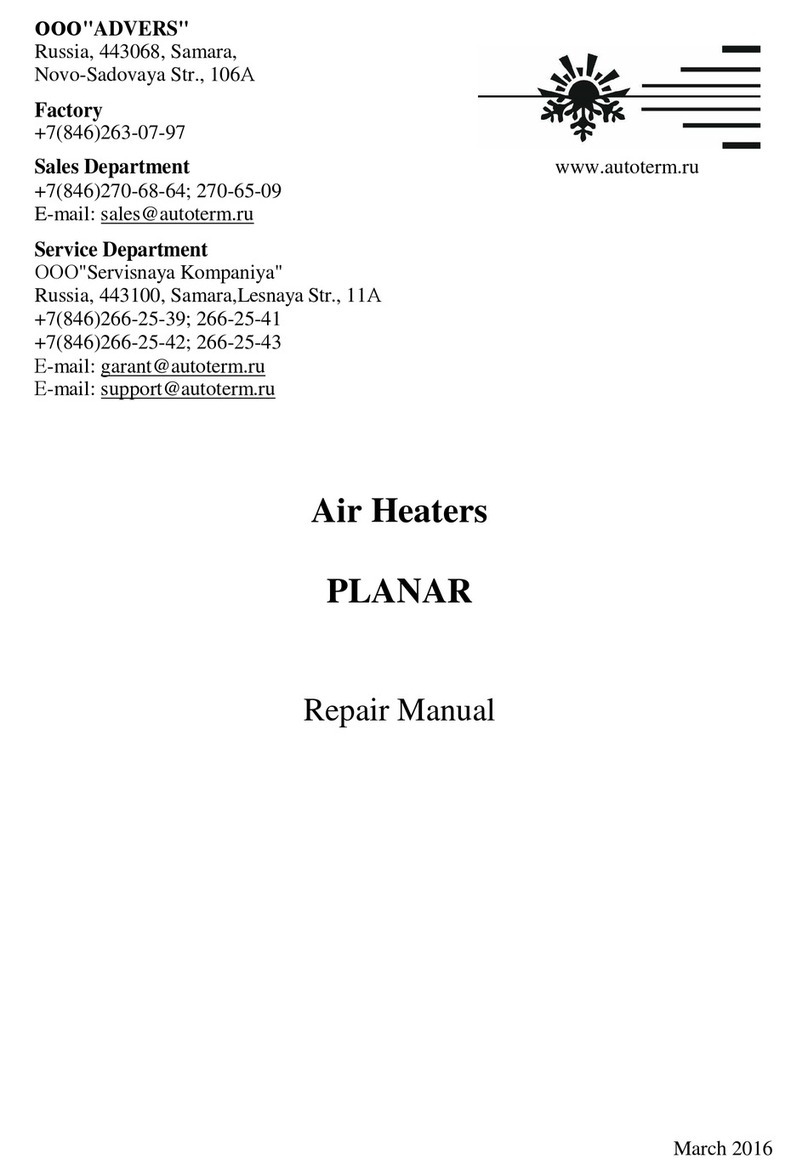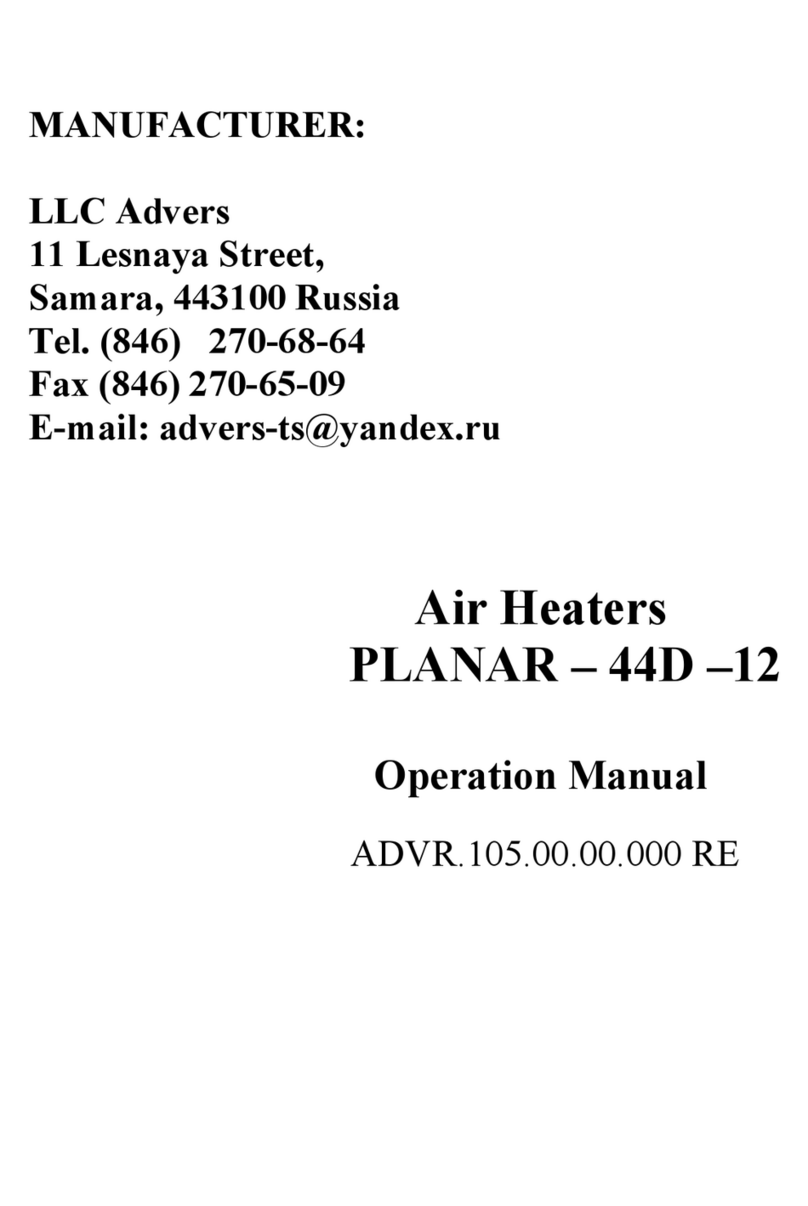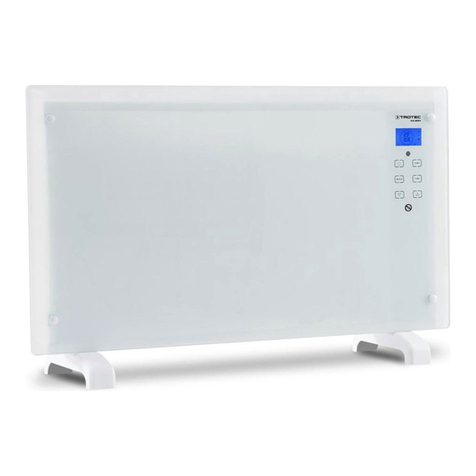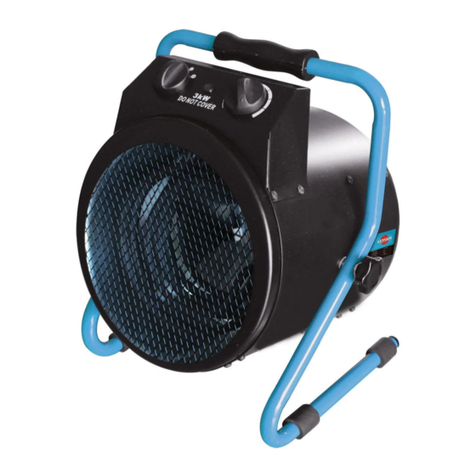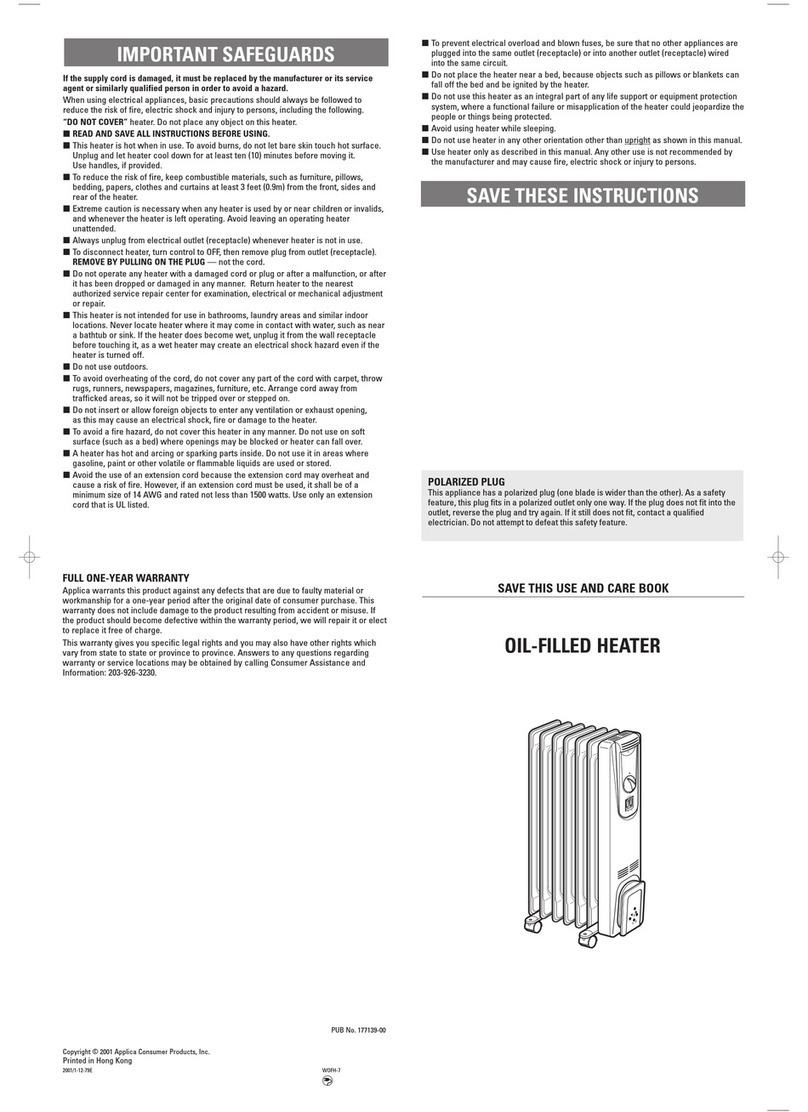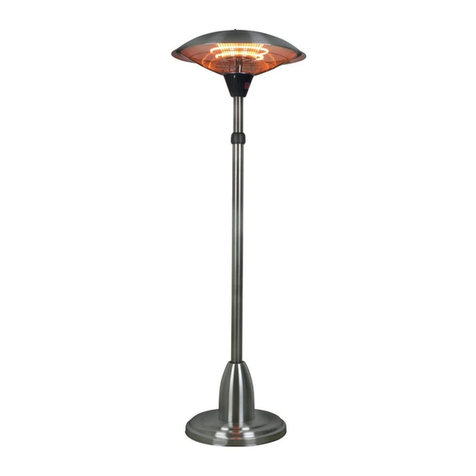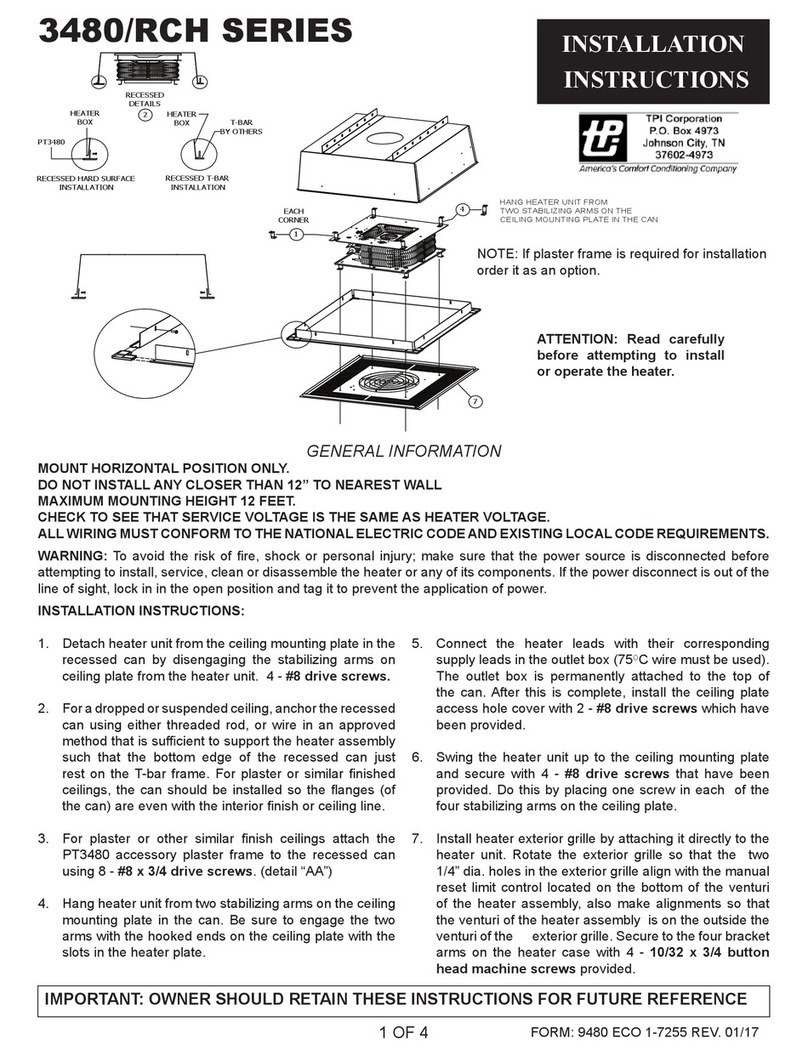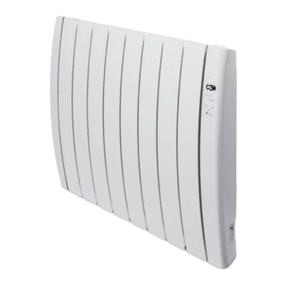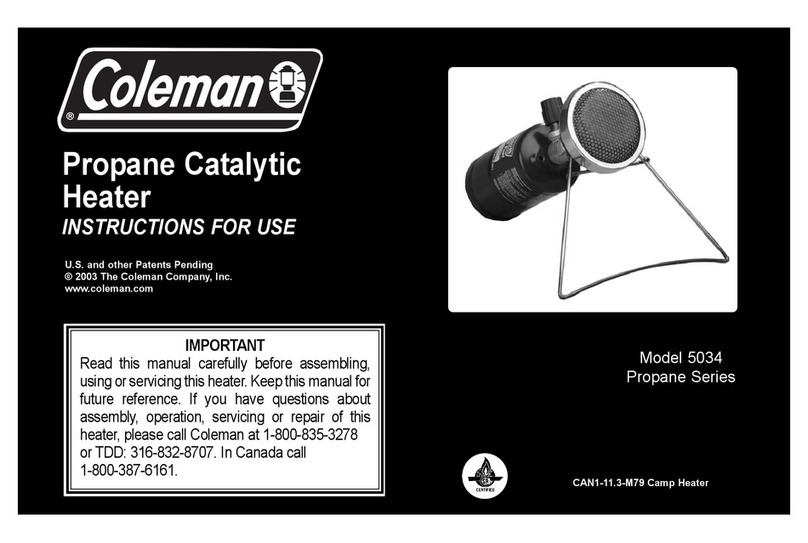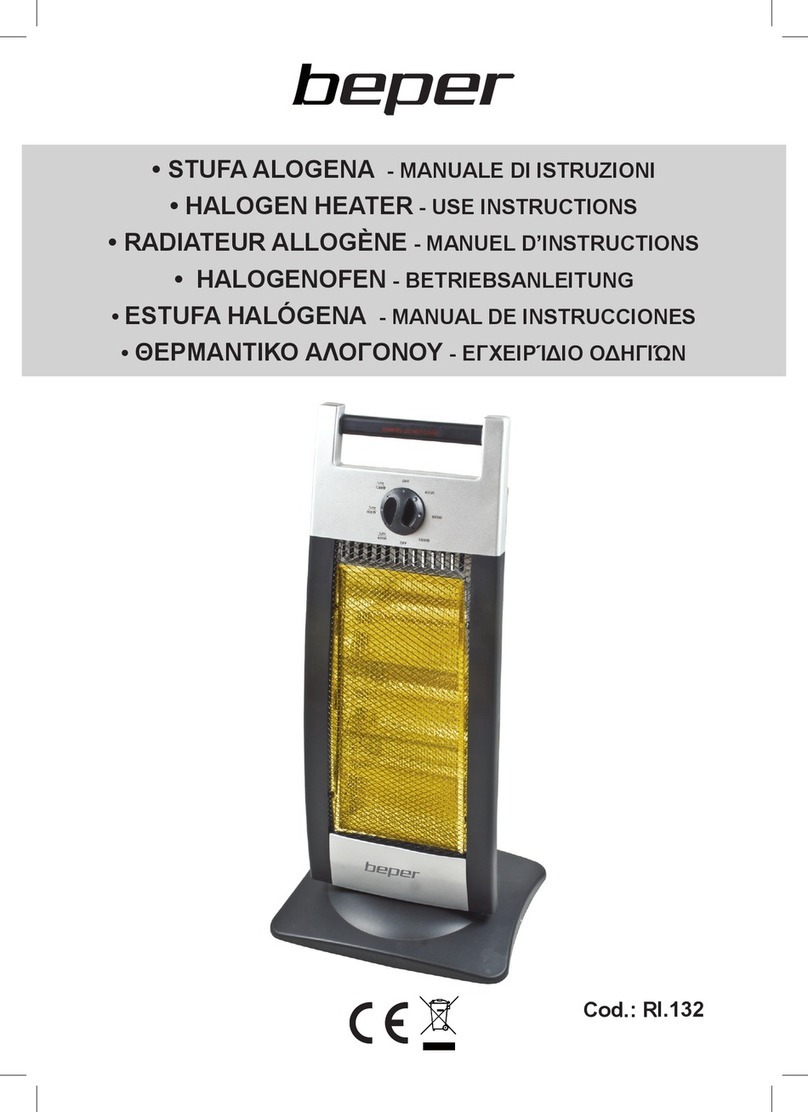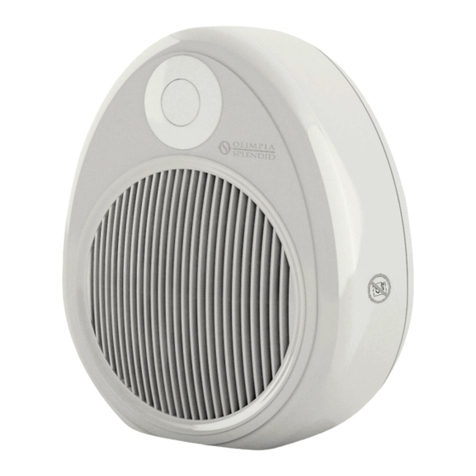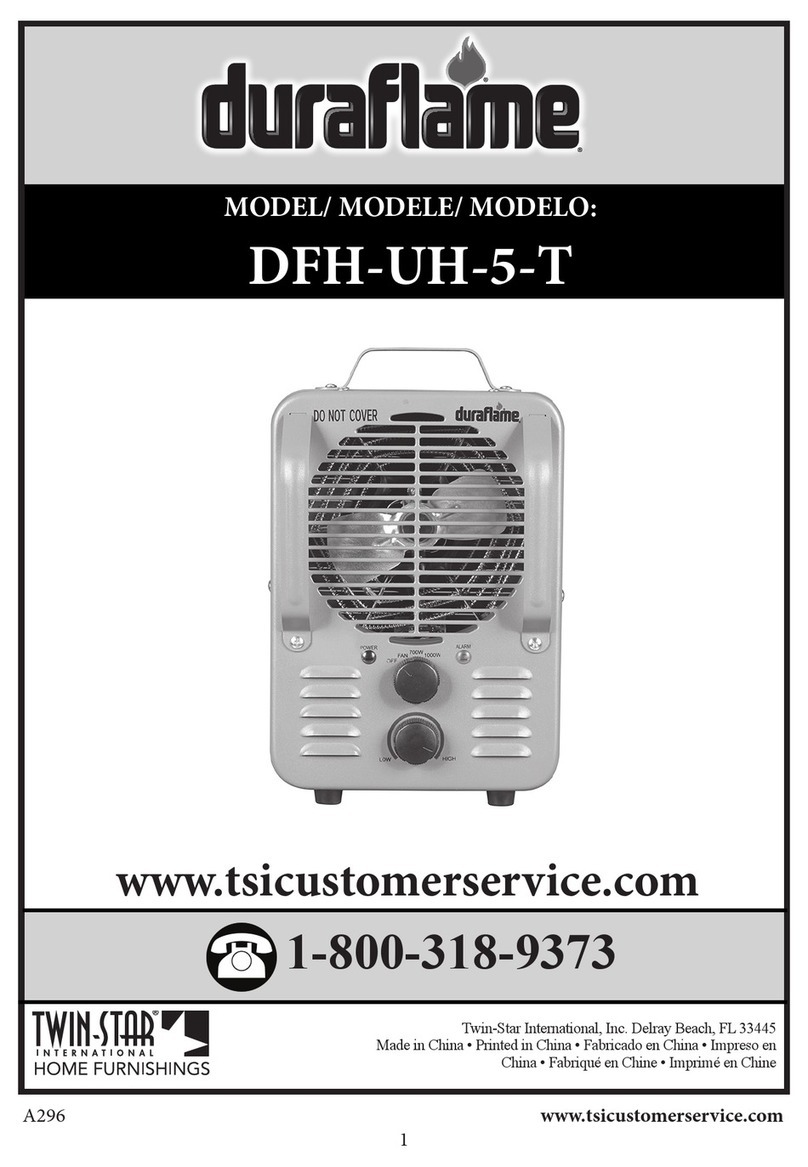Advers PLANAR-4D-12 User manual

MANUFACTURER:
LLC Advers
11 Lesnaya Street,
Samara, 443100 Russia
Tel. (846) 270-68-64
Fax (846) 270-65-09
Air Heaters
- PLANAR – 4D –12
Operation Manual
ADVR.010.00.00.000 RE

ADVR.010.00.00.000 RE. Sheet 2 of 26
TABLE OF CONTENTS
Sheet
1 Introduction 3
2 Basic Parameters & Specifications 3
3 Safety Measures 4
4 Description of Heater Operation and Structure 5
5 Heater Control Unit 8
6 Scope of Supply 8
7 Control Unit Functions 10
8 Installation Requirements 16
9 Post-Assembly Testing 21
10 Recommendations 21
11 Possible malfunctions during operation and Remedial Procedure 23
12 Transportation and Storage 23
13 Warranty 23
14 Packing Certificate 24
15 Acceptance Certificate 24
16 Vending & Assembly Certificate 25
17 Warranty Certificates 26

ADVR.010.00.00.000 RE. Sheet 3 of 26
1 Introduction
This Operation Manual is intended to familiarize the User with salient features,
operation, assembly and operating procedures for PLANAR–4D-12 (hereinafter
called “the heater”) intended for heating a vehicle driver workplace and various
compartments of a motorized vehicle at atmospheric temperatures as low as -45°С(-
113 F).
The complete operative scope of the heater comprises the following functions:
- provision of controllable air heating for an inhabited enclosed area in accordance
with the atmospheric air temperature,
- provision of forced air ventilation for an inhabited enclosed area.
Minor changes performed on the heater structure by the Manufacturer may not be
documented in this Operation Manual.
When placing an order or referring to the heater in documents pertaining to other
types of equipment, the heater codes will read as follows:
Diesel Air Heater PLANAR–4D-12 TU4591-008-40991176-2005,
2 Basic Parameters & Specifications
The basic heater specifications are quoted in Table 1.
The basic parameters are quoted to a margin of ±10% tolerance at a temperature of
20°Сat a nominal voltage.
Table 1
Version
Parameter Code
PLANAR–4D–12
Nominal Supply Voltage, V 12
Fuel Type Diesel Oil in compliance with GOST 305,
atmospheric temperature-dependent
Heating Efficiency:
max, kw,
min, kw,
3
1
Heated Air Volume:
Max , m3/hr
Min, m3/hr
120
70
Fuel Consumption at:
Max power, l/hr
Min power, l/hr
0.37
0.12
Start/Stop Mode Manual
Maximum Weight, kg 8
Heater power consumption,W
Doesn’t exceed while heating
mode
Max,W
Min,W
45
10

ADVR.010.00.00.000 RE. Sheet 4 of 26
3 Safety Measures
3.1 The installation of the heater and its fittings shall be performed by authorized
organizations only.
3.2 The heater may only be used for the purposes specified herein.
3.3 The fuel supply line shall not be installed inside the passenger compartment or
cabin of a motor vehicle.
3.4 A vehicle that uses the heater shall be equipped with a fire extinguisher.
3.5 The environment where the heater is to be used shall be free of highly
inflammable vapours and a large quantity of dust.
3.6 To prevent the possibility of exhaust gas poisoning, the heater shall not be
used when the vehicle is in an enclosed area (garage, workshop, etc).
3.7 When refueling the vehicle, the heater shall be switched off.
3.8 When performing welding operations on the vehicle or repairs on the heater,
disconnect the heater from the vehicle battery.
3.9 When assembling or dismantling the heater, observe the safety measures
specified by electric work regulations for the fuel supply system and the vehicle’s
wiring system.
3.10 The heater shall not be connected to the vehicle electric circuit while the
engine is running or the battery is switched off.
3.11 The heater’s electric power supply must not be disconnected before the
end of the purge cycle.
3.12 The heater’s connectors must not be connected or disconnected while the
heater’s electric power supply is turned on.
3.13 Wait 5 to 10 seconds before switching the heater back on.
3.14 In the event of two subsequent ignition failures, contact the maintenance
department to report a malfunction.
3.15 In the event of a failure in heater operation, contact a designated repair
organization authorized by the Manufacturer.
3.16 Manufacturer warranty shall not apply if the above requirements are not
adequately met.

ADVR.010.00.00.000 RE. Sheet 5 of 26
4 Description of Heater Structure and Operation
The heater operates independently from the vehicle engine.
The fuel and electric power supply is provided by the vehicle. See Figure 4.1 for
the heater wiring diagram.
The heater is a self-contained heating device comprising the following:
-Heating device (See Figure 4.2 for basic components thereof);
-Fuel supply pump providing fuel for the combustion chamber;
-Ignition and indicator device (control unit);
- Wiring harness connecting heater fittings to the vehicle battery.
The heater’s operating principle is based on heating air driven through the vehicle’s
heat exchange system.
The heat source are fuel combustion gases from the combustion chamber. The
resulting heat warms the walls of the heat exchanger, which is air-blown from the
outside. Air passes through the ribbing of the heat exchanger and enters the passenger
compartment or other compartments of the vehicle.
Upon ignition, check the heater to ascertain whether fittings such as the flame
indicator, the overheat sensor, air pump motor, plugs, fuel supply pump and the electric
circuits thereof are working properly.
If no problem is detected, the ignition process starts.
In accordance with the preset sequence, the combustion chamber is fore-purged
and the heating plug warms up to the required temperature. Air and fuel starts to enter
the combustion chamber under the same procedure, whereupon the ignition process is
initiated. Once stable combustion is achieved, the heating plug switches off. Flame
control is provided by the flame indicator. All processes involved in heater operation
are monitored by the control unit.
The control unit controls heat exchanger temperature and halts the combustion
process as soon as the temperature exceeds the specified limit. The heater may be
switched off at any time.
Pressing the heater deactivation command stops the fuel entering and the
combustion chamber is purged with air.
During automated operation control of the heater in emergency situations, bear in
mind the following:
1) In the event of ignition failure, the process will be repeated. The heater will
switch off following two consecutive ignition failures,
2) If a combustion failure occurs while the heater is in operation, the heater will
switch off,
3) If the heat exchanger is overheated (maybe as a result of closure of the heater
inlet/outlet vents), the heater will switch off automatically,
4) If voltage drops below 10.5 V or exceeds 16 V the heater will switch off.
5) In the event of emergency shutdown, the indicator will show the information
according to the code of malfunction.(see table 7.1)
Flashing frequency corresponds to failure type, see Section 12 for details.

ADVR.010.00.00.000 RE. Sheet 6 of 26
XÐ3, ÕÐ13 ÕS3, ÕS13
XP1
XS1
Control unit
Heater
Vehicle
-
+12V
Battery
Flame indicator
black*
red*
Glow plug
Bi-metall termo breaker
XÐ1
XS1
2
1
2
1
4
Circuit
input data
General
output data 3
+12V
Control Panel
fuel pump
XS13
XP13
1
+12V
Circuit
-12V 2Supply harness
Air pump
black*
black*
1
2
Circuit
+12V
General
green*
yellow*
XÐ5 XS5
121
2
white
yellow
green
brown
red-white
red
black
2
1
4
General
3
+12V
Circuit
XS4
XÐ4
Output data
input data
blue
red-white
black
25À
25À
red
C
o
n
t
r
o
l
P
a
n
e
l
h
a
r
n
e
s
s
1234
1234
12
21
2
Control
General
1
XP5
XS5
Fuel pump harness
blue
2
1
XS3 XP3
blue
red
Control
General
brown
yellow
white
green
Circuit Circuit
1
5
51
XÐ4 XS4
5
* - the colorof marking on flameindicator and air pump wiring .
black
red 2
1
Circuit
red
black
XP2
XS2
Sensor
General
1
2
1
2
Cabin temperature sensor
XS2 XP2
1
2Alumel
Chromel
Circuit
1
2
Circuit
PWM
Revolutions
XÐ3, ÕÐ13 ÕS3, ÕS13
XP1
XS1
Control unit
Heater
Vehicle
-
+12V
Battery
Flame indicator
black*
red*
Glow plug
Bi-metall termo breaker
XÐ1
XS1
2
1
2
1
4
Circuit
input data
General
output data 3
+12V
Control Panel
fuel pump
XS13
XP13
1
+12V
Circuit
-12V 2Supply harness
Air pump
black*
black*
1
2
Circuit
+12V
General
green*
yellow*
XÐ5 XS5
121
2
white
yellow
green
brown
red-white
red
black
2
1
4
General
3
+12V
Circuit
XS4
XÐ4
Output data
input data
blue
red-white
black
25À
25À
red
C
o
n
t
r
o
l
P
a
n
e
l
h
a
r
n
e
s
s
1234
1 2 3 4
12
2 1
2
Control
General
1
XP5
XS5
Fuel pump harness
blue
2
1
XS3 XP3
blue
red
Control
General
brown
yellow
white
green
Circuit Circuit
1
5
51
XÐ4 XS4
5
* - the colorof marking on flameindicator and air pump wiring .
black
red 2
1
Circuit
red
black
XP2
XS2
Sensor
General
1
2
1
2
Cabin temperature sensor
XS2 XP2
1
2Alumel
Chromel
Circuit
1
2
Circuit
PWM
Revolutions
figure 4.1- Wiring Diagram

ADVR.010.00.00.000 RE. Sheet 7 of 26
Figure 4.2 – Basic Heater Components

ADVR.010.00.00.000 RE. Sheet 8 of 26
5 Control Unit
The control unit and the control panel control the heater.
The control unit performs the following functions:
а) initial diagnostics (serviceability check) of heater fittings during ignition,
b) diagnostics of heater elements throughout operation,
c) heater activation/deactivation by command from control panel;
d) combustion process control;
e) automated switching of ventilation after the combustion process stopped;
f) automated deactivation of the heater occurs:
- in the event of failure of one of the controlled elements,
- when any parameter exceeds the specified limit (heat exchanger temperature,
supply voltage, combustion chamber flame failure)
6. Scope of Supply
See Figure 6.1 for scope of supply and connection diagram of basic heater
components. For list of basic heater components, see Table 6.1.
22
Surface of cabin
(vehicle)
11
4
20
21
51
19
30
38
43
52
36
36
38 (4øò.)
41 (4øò.)
43 (4øò.)
27 (4øò.)
25
18
30
38
17
30
38
17
30
38
30
38
43
2
36
30
38
43
50 (8øò.) 9
18
ÕS1
ÕS3
ÕP13
6
53
12
+
-
13
49
10±1
1
8
Fuel
5
ÕP2
22
Surface of cabin
(vehicle)
11
4
20
21
51
19
30
38
43
52
36
36
38 (4øò.)
41 (4øò.)
43 (4øò.)
27 (4øò.)
25
18
30
38
17
30
38
17
30
38
30
38
43
2
36
30
38
43
50 (8øò.) 9
18
ÕS1
ÕS3
ÕP13
6
53
12
+
-
13
49
10±1
1
8
Fuel
5
ÕP2
Figure 6.1 – Connection Diagram of Basic Heater Components

ADVR.010.00.00.000 РЭ. Sheet 9 of 26
Table 6.1
No. Designation Pieces Per
Set
1 Heater 1
2 Control panel ПУ-8 with harness 1
4** Fuel Supply Pump, Holder, Clamp (Set), Gasket(set) 1
5 Cab temperature sensor 1
6 Fuel Supply Pump Harness 1
8 Fuel supply intake 1
9 Heat insulation 1
11 Air Intake 1
12 Power Supply Harness 1
13* Screen 1
17 Holder 2
18 Exhaust Pipe Clamp 3
19 Air Inlet Clamp 1
20** Shock absorber 1
21** Holder 1
22 Exhaust Pipe 1
25 Connecting Tube (polyamide) L = 5500 mm 1
27 Socket (L= at least 50 mm) 4
30 Bolt М6х16 7
36 Screwm6.4*16 4
38 Nut М6 11
41 Enlarged Flat Washer ∅6 4
43 Split Washer ∅6 8
49* Clamp Torro 20*32/9W1 1
50 Clamp АВА min 10\9 8
51** Clamp Torro 35*50/c7W1 1
52 Clamp 13*26 1
53 Plastic Clamp 15

ADVR.010.00.00.000 РЭ. Sheet 10 of 26
7 Control Panel Functions
7.1 The control panel is intended for:
-heater activation and deactivation in manual mode;
-setting operation mode according to desired power or temperature;
-heater status indication (from the sensor integrated in the heater, control panel unit or
external sensor if connected;
-failure code indication in case of heater failure while operation.
The front board of the panel contains: four-digit light emitting doide (LED)
indicator, two LEDs and three knobs. Functionality of the knobs and LEDs. (fig.7.1)
LED indicator N1
(temperature mode)
(power mode)
LED indicator N2
mode selecting/decreasing
of power or temperature Sensor selecting/increasing of
powerortemperature
Setting of operation mode/heater
ON-OFF knob
12
C
a
b
i
n
t
e
m
p
e
r
a
t
u
r
e
s
e
n
s
o
r
(if connected)
Heater temperature
sensor
Control panel
temperature sensor
LED indicator N1
(temperature mode)
(power mode)
LED indicator N2
mode selecting/decreasing
of power or temperature Sensor selecting/increasing of
powerortemperature
Setting of operation mode/heater
ON-OFF knob
12
C
a
b
i
n
t
e
m
p
e
r
a
t
u
r
e
s
e
n
s
o
r
(if connected)
Heater temperature
sensor
Control panel
temperature sensor
Fig. 7.1- Control panel
While first time the heater is connected to electric circuit of the car or after
breaks of power supply, according to environmental temperature there will be
following information on the panel (for example)- the temperature in the area of the
sensor installed in the heater is -12°C (drawing 7,2), if the temperature in the area of
the sensor is above zero, there will be no “mines” before the figure.
12
12
fig 7.2- View of the indicator after connection to electric circuit of the heater (initial
stage of the indicator)

ADVR.010.00.00.000 РЭ. Sheet 11 of 26
With the view to energy saving , the indicator stops glowing 20 seconds after last
pressing of any knob, while this LED#1 or LED#2 is :
-lightning constantly if the heater is activated;
-blinking rarely (1 time per 1,5 second) if the heater is not activated;
-blinking while fault (1 time per second);
-blinking frequently (5 times per second) while deactivation of the heater (while
purging)
To restart the indication there’s need to press any knob.
7.2 Succession of work with the control panel
7.2.1 Operation mode set up.
Before heater activation there’s need to select operation mode. Pressing knob with
the arrow “A” select operation mode of the heater according to desired power or
temperature. According to the choice the LED#1 orLED#2 is lightning. After selecting
the mode “according temperature” there’s need to press knob with the arrow “B” and
choose the sensor, according which the temperature of the heater will be controlled.
7.2.2 Activation and setting the power or temperature.
After mode selection there’s need to press the knob “O”, while this the heater will
start working and there’s information on the indicator- the power mode or
temperature mode according to your choice.(see fig. 7.3 or 7.4)
1818
Fig. 7.3 (power mode) Fig. 7.4 (temperature mode)

ADVR.010.00.00.000 РЭ. Sheet 12 of 26
If power mode is selected, pressing knobs with arrows “A” (decreasing),
“B”(increasing) – you can set up the necessary power (see fig. 7.3)which can be set
within 1 to 3 kWt. The indicator shows the scale according which the power is set up.
If temperature mode is selected , pressing knobs with arrows “A” (decreasing),
“B”(increasing) – you can set up the necessary temperature (see fig. 7.4). The
temperature is set within 15° to 30°C. You can see the figures on the indicator.
Attention!
1. The heater Operation mode (according to power or temperature) is saved
until new set up.
2. If cabin temperature sensor circuits are disconnected heater will go
working on middle power Operation mode.
3.While heater activation without setting operation modes it is necessary to
press the knob “O” one time if the indicator is lightning, and 2 times if the
indicator is not lightning.
7.2.3 Heater deactivation.
To deactivate the heater press the knob “O”. While this the heater is in switching
off mode, that means that the combustion process in combustion chamber is stopped
and the process of purging is started. According to the mode the indicator will show
information(for example) (see pictures 7.5 or 7.6), the LED#1 or LED#2 will be
blinking frequently until the process of purging is stopped.
2525
Picture 4.5-Purge Picture 7.6- Purge
Attention!
It is forbidden to switch off electric power supply before purge cycle is
finished.

ADVR.010.00.00.000 РЭ. Sheet 13 of 26
7.2.4 Indication of malfunction code while failures in heater operation
While heater activation and operation there can be malfunctions. In case of
malfunction the control unit automatically deactivate the heater. Every malfunction is
coded and automatically appears on the indicator(see fig 7.7). While this, malfunction
‘s code and the LED showing the operation mode of the heater will blink rarely. The
heater’s malfunction codes are described in table 7.1. Pressing of any knob of the
control panel will switch off indication of the malfunction code and bring the control
panel in initial state.
0202
fig 7.7
Table 7.1-Malfunction codes
Malfunction code Problem description Commentary
Problem solution
01 Heat Exchanger overheating
Check the inlet/outlet pipe
of the heater for
unpumped heated air
flow. Check the overheat
sensor on the heat
exchanger, replace if
necessary.
02 Possible overheating on
temperature sensor. The sensor
temperature (control unit) is more
than 55°C
While purging before start
the control unit is not
cooled enough or control
unit is overheated during
operation. Check
inlet/outlet pipe of the
heater for unpumped
heated air flow and repeat
activation to cool the
heater.
04 Built-in temperature sensor on
control unit failure
Replace the control unit

ADVR.010.00.00.000 РЭ. Sheet 14 of 26
05 Flame indicator failure Check the flame indicator
circuit for disconnection
fault with sensor
disconnected of its plate.
Resistance between
contacts should not
exceed 10 Ohm. Replace
the indicator if it is not
operational.
08 Flame failure Check the fuel level and
fuel supply system. Check
combustion air system
and the exhaust pipe line.
If the heater can be
started, check fuel pump
and replace if necessary.
09 Heating plug failure Check the plug and
replace if necessary.
10 Air pump motor failure Check the wiring of the
air pump, replace motor
if necessary.
12 Shutdown, voltage boost Check the battery,
regulator and power
supply wiring. The
voltage between 1 contact
and 2 contact of connector
XP13 (see connection
layout picture 4.1) should
not exceed 16V
13 No further activation attempt is
possible
If possible quantity of
activation attempts is
used, check the heating
plug, fuel level and fuel
supply system. Check
combustion air system
and exhaust pipe line.
15 Shutdown, low voltage Check the battery,
regulator and power
supply wiring. The
voltage between 1 contact
and 2 contact of connector
XP13 (see connection
layout picture 4.1) should
not exceed 10.5V

ADVR.010.00.00.000 РЭ. Sheet 15 of 26
16 Ventilation period takes longer
than usual
The heater is not cooled
sufficiently during the
purge. Check the
combustion air supply
system and exhaust pipe
line. Check the flame
indicator and replace if
necessary.
17 Fuel pump failure Check fuel pump wiring
for short-circuit fault or
disconnection fault.
Replace the pump if
necessary.
20 No connection between Control
panel and the heater
Check wiring, connectors.
27 Air pump motor fault. Motor
won’t rotate
Check air pump motor
wiring, connector.
28 Air pump motor fault. Motor
won’t switch off, go on rotation
Check air pump motor
wiring, replace motor if
necessary.
7.3 Control Panel installation and connection
Control Panel is installed in cabin or passengers compartment on the dashboard
or any other comfortable for the driver place.
The control Panel is fixed with double-faced adhesive tape, which is stuck to the
back side of the Control Panel. You can take out wires of the unit from its back or side
cover. It is necessary to degrease the surface used for Control panel installation. Take off
protective film from the tape and install the Control Panel on the prepared surface.
The connection of the Control panel to the heater is performed according wiring
diagram(see fig. 4.1)
7.4 Complex checkup of the Control Panel after installation
After installation and connection of the Control panel to the heater the checkup is
performed in following way:
-set up the necessary operation mode on the Control panel;
-check activation and deactivation of the heater;
-check deactivation of the heater while artificial failure (take off the connector
from the fuel pump during operation mode of the heater), while this the malfunction
code appears on the indicator.
7.5 Possible malfunctions
If after pressing any knob of the Control Panel the indicator is not lightning, there
should be checked:
-fuses-25A;
-connectors and wires.
The Control Panel is not subjected to repair, it should be replaced for a new one.

ADVR.010.00.00.000 RE. Sheet 16 of 26
8 Installation Requirements
8.1 Heater Installation
Installed the heater indoors while bearing in mind the permissible operating
positions shown in Figure 5. The figure shows the two maximum assembly positions of
the heater. Positioned the heater’s inlet vent in such a way to prevent absorption of
vehicle/heater exhaust gas in normal operating conditions. The gap between the
walls/partitions and the edge of the inlet vent shall be at least 50 mm (see Figure 8.1).
When assembling or operating the heater, ensure that no foreign objects enter the
inlet/outlet vents. Prior to assembly, ensure availability of spare heating plug and bear
in mind dismantlement requirements, as this will permit easier maintenance in future.
See Figure 8.2 for how to position mounting holes to install the heater into the motor
vehicle casing. Overall and mounting Dimensions are on the fig.8.3
ATTENTION !! To ensure reliable performance, follow the above
recommendations carefully. Install the heater horizontally with the heating plug
in the up position as shown in Figure 8.1.
Figure 8.1 – Mounting Options

ADVR.010.00.00.000 RE. Sheet 17 of 26
18
55
44
12
Ô25
Ô21
Ô6,5
4 îòâ
.
Ç
11
Figure 8.2– Mounting Holes Used for Heater Installation
44
55
Ç
138
392
158
84,5
R26
Ç
157
12
18
Ç
147,5
Ç
90
14
82
160
24
M6
4 øïèëüêè
45
Å
40
Ç
82
103
8
ÕS3
ÕP13
Õ
S
1
17
44
55
Ç
138
392
158
84,5
R26
Ç
157
12
18
Ç
147,5
Ç
90
14
82
160
24
M6
4 øïèëüêè
45
Å
40
Ç
82
103
8
ÕS3
ÕP13
Õ
S
1
17
Figure 8.3- Heater dimensions
8.2 Air Inlet Installation
Do not allow combustion air to be sucked in from the passenger compartment or
vehicle cabin or boot. Position the pipe’s air inlet vent to prevent snow entering or
choking the pipe and to allow incoming water to run off. Ensure the vent is not facing
oncoming air.
8.3 Exhaust Pipe Installation
When installing the exhaust pipe, be mindful of its high operating temperature. Cut
the exhaust pipe (a flexible corrugated metal hose) to size. Fix the exhaust pipe in
place using clamps and position it at a slight angle following the trajectory of gas flow.
To protect some parts of the vehicle (electric wiring and other harness) from high
temperatures, there must be heat insulation installed.( pos.9, fig.6.1)

ADVR.010.00.00.000 RE. Sheet 18 of 26
To achieve a tight fit, prior to connecting the exhaust pipe to the heater pipe, make
a saw-cut of about 15mm along the length of the exhaust pipe without going beyond
the gripped part of the pipe. Ensure that the end of the exhaust pipe does not come into
contact with the rubber seal of the heater. Direct exhaust gas outside. Position the gas
outlet vent and the air inlet vent in such a way as to prevent exhaust gas from entering
the combustion chamber. Ensure that exhaust gas does not enter the passenger
compartment of the vehicle and that it does not get sucked in through the vehicle fan.
Do not allow exhaust gas to affect the performance of vehicle components. Position
the exhaust pipe outlet vent so as to prevent snow entering or choking the pipe and to
allow incoming water to run off. At the vent of the exhaust pipe the screen is installed,
this necessary for stable operation of the heater while working low idle. If thee screen
is not installed, install it according fig.6.1 Ensure the vent is not facing oncoming
air.
8.4 Installation of Heater Fuel Supply System
8.4.1 installation of Heater fuel pump
To prevent emergency situations, follow these instructions carefully.
The fuel supply pump should be mounted as close to the fuel tank as possible
and positioned below the tank’s lower fuel level.
To prevent the possibility of fuel leaking out of the tank (due to gravity flow) as
a result of faulty sealing of the fuel supply pump, the fuel tank should be positioned in
such a way that the maximum fuel level is below the incision in the heater fuel tube.
The spatial position of the fuel supply pump must comply with Figure 8.4
(preferably in a vertical position).
а– lift height up to 700 mm; b – delivery lift between fuel supply pump and heater up
to 1500 mm.
Figure 8.4- Permissible Mounting Position of Fuel Supply Pump

ADVR.010.00.00.000 RE. Sheet 19 of 26
8.4.2 Fuel intake through fuel supply intake.
Fuel can enter the heater through a fuel supply intake from the fuel tank according to
fig.8.5. a) Perform installation of special washer with fuel supply intake to the tank
inlet according to fig.8.5,b) Perform installation of the fuel supply line from fuel
supply intake to the heater according to fig.8.6.
6
2
4
3
Ç
16
5
5
Êîðïóñ òîïë. áàêà
1
Ç
16
1
à
)
á)
6
2
4
3
Ç
16
5
5
Êîðïóñ òîïë. áàêà
1
Ç
16
1
à
)
á)
1 - fuel supply intake 4-washer 8
2- nut 8 5- special washer
3- washer 8 6-gasket
Fig 8.5 – Fuel supply intake installation
2
1
5
2
0
0
0
ì
ì
m
a
x
4
0
0
0
ì
ì
m
a
x
5
5
4
3
3
5-7 ìì
Íàãðåâàòåëü
4
5
6
í
å
á
î
ë
å
å
5
0
0
ì
ì
m
a
x
1 - liquid phase heater fuel tank
4 - fuel pump
2- fuel supply intake of liquid phase
heater
5 - sleeve
3 – fuel supply line d=2mm 6 – fuel supply line d=5mm
Figure 8.6 – Installation Diagram for Heater Fuel Supply System Using a fuel supply
intake

ADVR.010.00.00.000 RE. Sheet 20 of 26
When installing the fuel supply line, do not allow connecting sleeves to bend.
Use a sharp knife to cut the fuel tube as in Figure 8.7. The cutting location shall be free
of indentations, hairs and must not restrict flow through the tube.
Правильно Неправильно
IncorrectCorrect
Figure 8.7 – Tube Cutting Prior to Installation
ATTENTION 1. Do not allow the fuel supply line or fuel supply pump to
overheat. Do not install the fuel supply line and fuel supply pump near the
exhaust pipe or on top of the engine.
2 The fuel supply line connecting the fuel supply pump to the
heating element of the heater should be installed at the same lifting angle.
8.5 Installation of Heater Electric Circuit
Heater wire harnesses shall be installed in compliance with the heater wiring
system as shown in Figure 4.1. When installing, do not allow the wire harnesses to
become overheated, deformed or dislodged during vehicle use. Attach the harnesses to
the vehicle fittings using plastic clamps.
Attention! Remove the fuse prior to installation.
8.6 Control Panel Installation
Install the control panel on to the dashboard in the cabin or passenger
compartment of the vehicle. Attach the Control panel with the help of adhesive tape.
Degrease the surface on which the panel is installed and remove protective film from
the adhesive tape.
Table of contents
Other Advers Heater manuals
